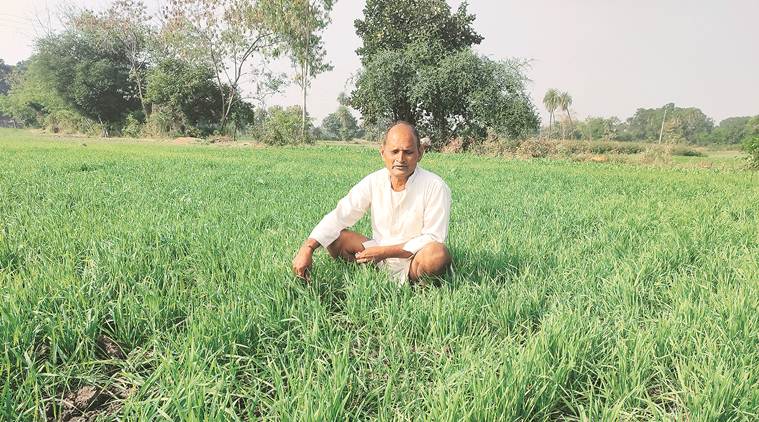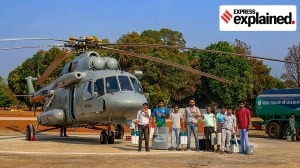- India
- International
Nutrient woes: Spoiling the party
Urea shortage is threatening to take the shine off farmers’ hopes of a bumper rabi harvest from surplus rains
 Santosh Vishwakarma bought urea for Rs 400 per bag, against the government-fixed rate of Rs 266.5. (Express photo: Milind Ghatwai)
Santosh Vishwakarma bought urea for Rs 400 per bag, against the government-fixed rate of Rs 266.5. (Express photo: Milind Ghatwai)
Sunil Kumar learnt his lesson a few years ago, when he had not stocked up on enough urea. His wheat yield suffered as the crop did not get the desired level of nitrogen for growth at the right time. Since then, the 33-year-old farmer from Amajhir village of Sehore district and tehsil has always taken care to procure sufficient quantity of the fertiliser well in advance of the rabi sowing season. The Class 10 pass, who cultivates 10 acres, purchased 14 bags of urea (each of 45 kg) in late-September, more than a month before he was to commence planting of wheat post Diwali.
Kumar’s decision was vindicated when he happened to go to the Primary Agricultural Cooperative Society (PACS) in the neighbouring village of Mogra Ram around mid-November. By then, most farmers had completed sowing operations and were desperately queuing up before the PACS store that sold Iffco (Indian Farmers’ Fertiliser Cooperative) urea. “I had never seen this kind of chaos before. Even the farmers who bought after standing in line for hours could manage to get only a few bags, much less than their requirement,” he recalls.
Farmers generally buy 2.5-3 bags of urea per acre for wheat. Out of that, the first bag is applied within 20 days of sowing, just before the first round of irrigation.
 Urea bags outside a fertiliser retail outlet. (Express photo: Milind Ghatwai)
Urea bags outside a fertiliser retail outlet. (Express photo: Milind Ghatwai)
Santosh Vishwakarma, a 12-acre farmer from Jatakheda village of Sehore — a district in Madhya Pradesh famous for production of the premium “Sharbati” wheat variety — was not as prescient as Kumar. He was late “by a few days” to turn up at the PACS in Naplakhedi, hardly 5 km from his village. The “few days” proved too costly. Frustrated by the long wait in the serpentine queue, which also fuelled uncertainty over whether he would get his bags of urea at the end of it, the 59-year-old decided to buy from a private trader.
“He charged Rs 400 per bag, way higher than the Rs 266.50 government-fixed rate I would have paid at the society. But I had no alternative. Without urea, my germinated seedlings would have wilted for lack of nutrition and there was no point giving water either,” says Vishwakarma. “Yes, I could have bought the fertiliser in advance, but there is always a chance of it getting spoilt by moisture. In any case, I had never faced this kind of problem, as urea was always available and you didn’t have to wait so long in lines. If there is a shortage, why don’t they just ration the urea and distribute it equally among farmers?” he asks, while accusing the PACS officials of favouring farmers with clout and ignoring “aam kisan (ordinary cultivators)” like him.

Lakhan Lal, a sahayak (assistant) at the Naplakhedi PACS, says the society is rationing the nitrogenous fertiliser. “The moment there is news, right or wrong, about a shortage, it creates panic. Farmers then start forming lines to buy even if the fertiliser is not required to be applied immediately. In the process, many don’t get even their basic quota of fertilisers. I haven’t seen such long queues for urea,” he adds.
Last year too urea shortage had been a huge issue in Madhya Pradesh — especially around the time of the Assembly elections in late-November. The Indian Express had reported about long queues in front of fertiliser outlets in many places. This time also there are similar reports — of tempers getting frayed, police deployment at stores and even the odd instance of urea bags being looted from trucks.
Plus, in the current rabi season, there is additional fertiliser demand due to surplus rains. Rainfall during the southwest monsoon season (June-September) was 61% above the normal long-term average for west Madhya Pradesh (which is the main wheat belt) and 25% excess in the eastern part of the state. West Madhya Pradesh also received 37% above-average rains in the ongoing post-monsoon season (starting October 1). With water levels in the state’s nine major irrigation dams at nearly 95% their full reservoir capacity and groundwater aquifers fully recharged as well, farmers have gone in for large-scale wheat planting.
As per data from the Union Agriculture Ministry, the all-India acreage under wheat, at 202.54 lakh hectares (lh) on December 6, was 4.3% higher than the 194.21 lh during this time last year. The figure is even higher, by 16.1 % (from 41.08 lh to 47.70 lh), for Madhya Pradesh.
At the same time, the progressive area sown under chana (chickpea) and masur (lentil) in the state has fallen from 30.78 lh and 5.14 lh to 21.98 lh and 4 lh, respectively. The latter two crops hardly require any urea, but the lack of any assured minimum support price-based government procurement means farmers prefer growing wheat — more so when there is plenty of water.
“Farmers usually stagger sowings and don’t cultivate their entire land for lack of water. But this time, with widespread rains, they have used up most of their land and everyone has almost simultaneously planted — and that too, wheat. So, there is naturally more demand for urea,” says Ghanshyam Patel, a 30-acre farmer, who has just bought six bags from the Naplakhedi PACS for the third time in the current season. In the previous two visits, he had managed to get 10 bags each.
At Pipaliya Mira village of Sehore tehsil, PACS manager Prahlad Singh is trying his best to humour farmers, as they wait for another vehicle with urea to arrive. The entire material from an earlier truck carrying 560 bags just got fully sold in no time. This society, catering to six villages, had sold 198 tonnes of urea during the last rabi season. This season, with three months still to go, the society has already sold 231 tonnes.
“Jinne jugaad kar li, unko mil gaya (the ones with connection have got their supply),’’ says Ismail from Gudbhela village, as he watches a truck pass by on the highway, not far from his 12-acre plot. According to him, reports about acute shortage aren’t entirely true because “everyone has got something, but they want more”. He himself has managed eight bags and is keen to have more. “In many fields, the leaves have started drying up and yellowing. If we do not apply immediately, our yields will fall. We cannot afford this, when most of us practically lost our soybean crop because of heavy rains during the kharif season. Farmers are hoping to recover from wheat what they lost in soybean,” sums up Ismail.
The ruling Congress in Madhya Pradesh is blaming the BJP-led government at the Centre for the crisis. Chief Minister Kamal Nath claims his government sought 18 lakh tonnes (lt) of urea for the state in the current rabi season. As against this, the Centre allocated 15 lt, which is lower than the supply of 15.41 lt during the last rabi season from October 1 to December 31, 2018. “Reduced supply, along with higher and simultaneous demand from farmers, has led to some trouble,” he admits.
Former CM Shivraj Singh Chouhan, however, attributes the shortage to the absence of planning. “When our government was in power, we used to do detailed analysis of urea demand, both for kharif and rabi, and stock enough material in advance. Today, even when urea arrives, it is not distributed properly, leading to black marketing,” he alleges.
The Department of Fertilisers data shows total urea sales this kharif season (April-September) to have dropped to 20.67 lt, from 26.75 lt during the same period of 2018. But sales in October-November 2019 have been higher, at 16.78 lt, compared with 13.73 lt for October-November 2018.
Best of Express
Buzzing Now
Apr 18: Latest News
- 01
- 02
- 03
- 04
- 05






































